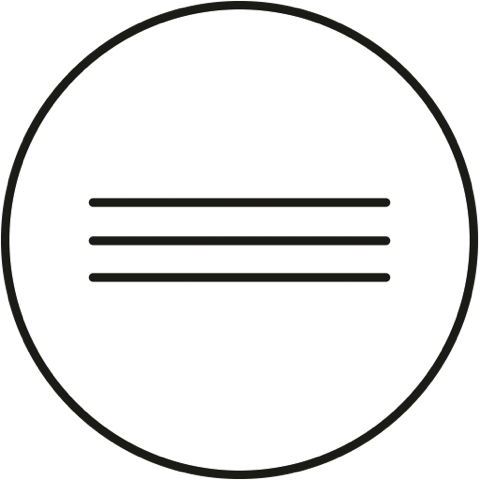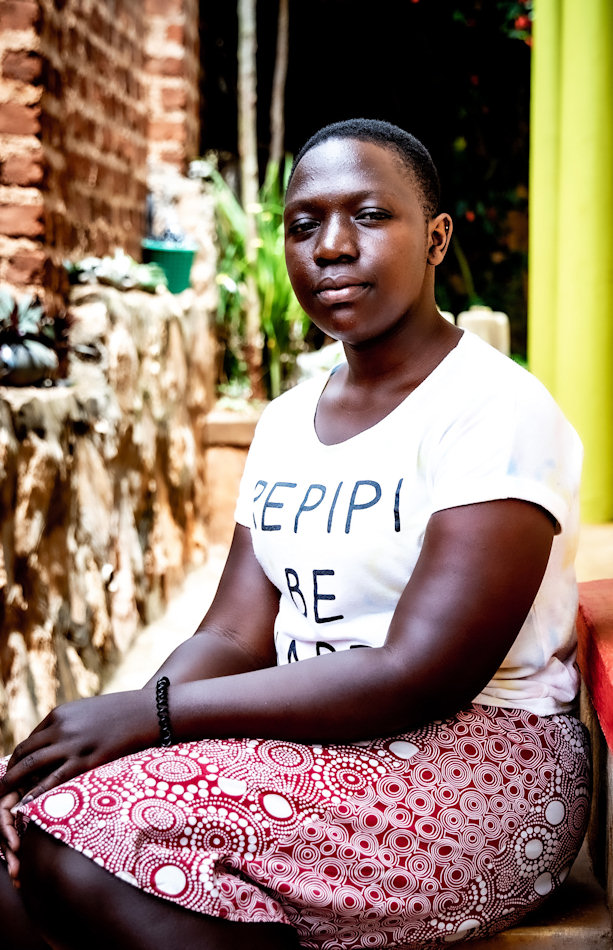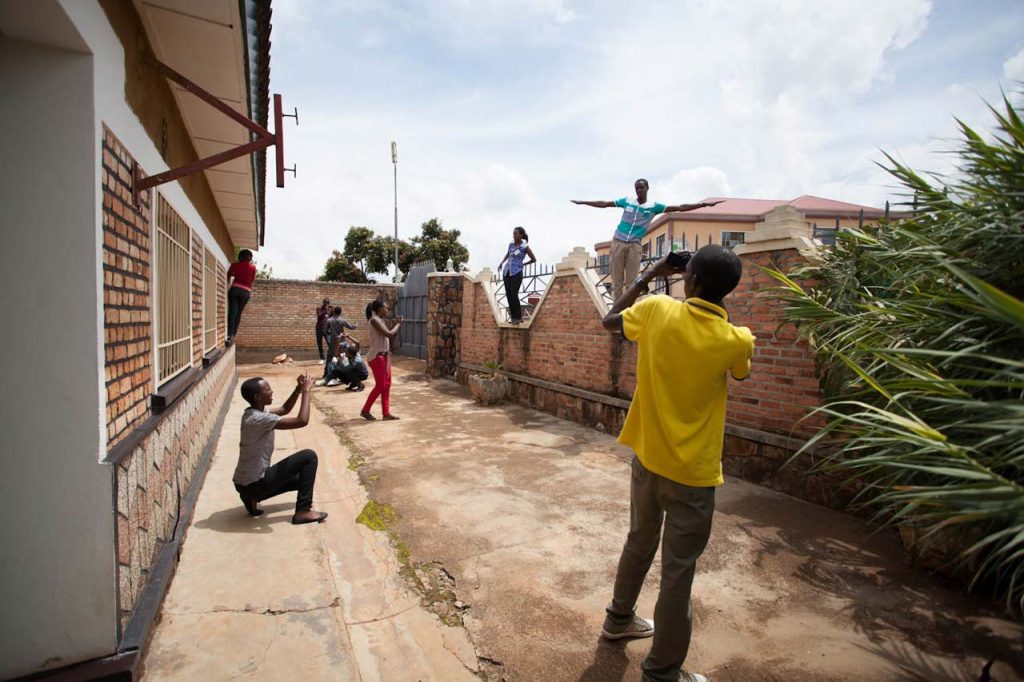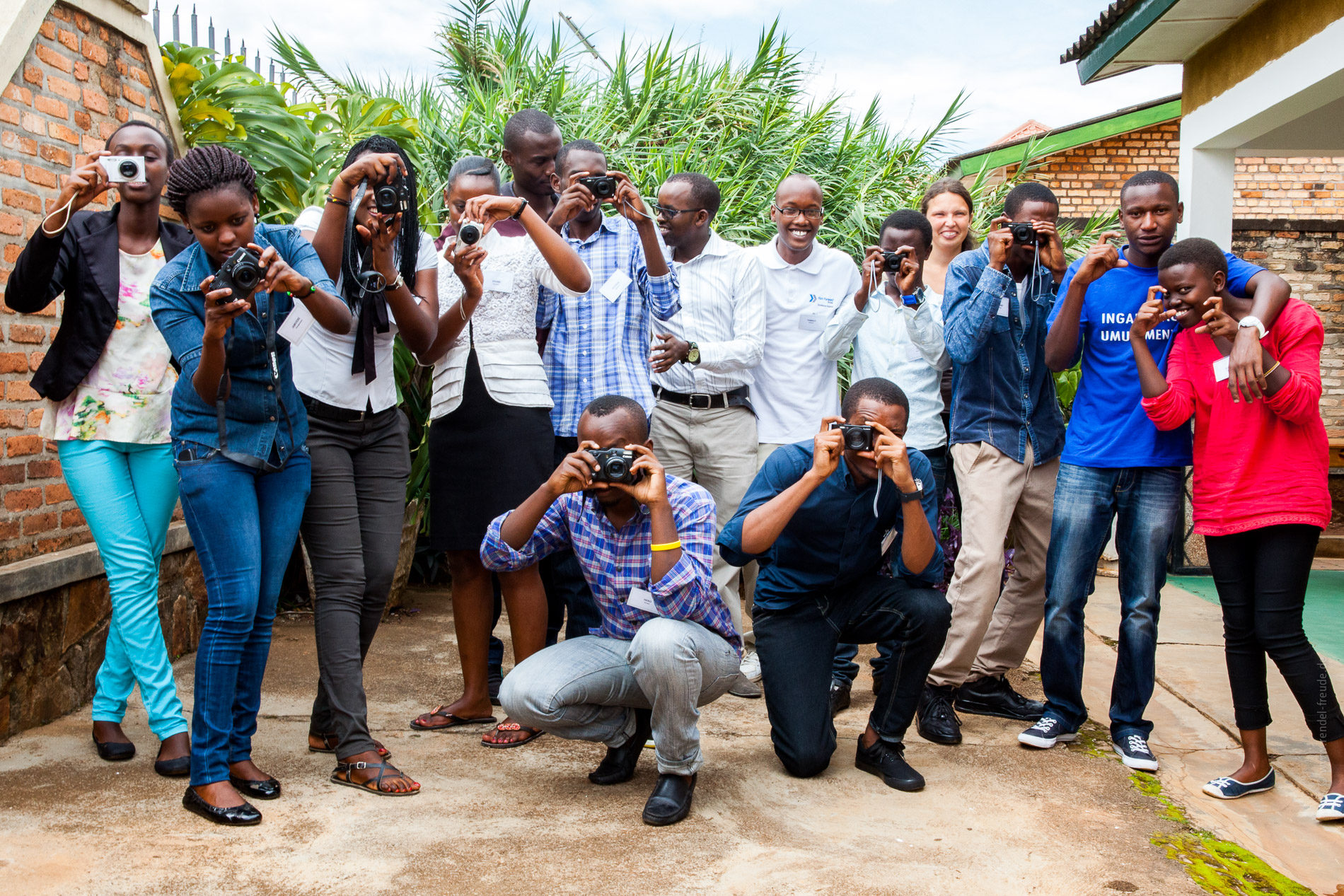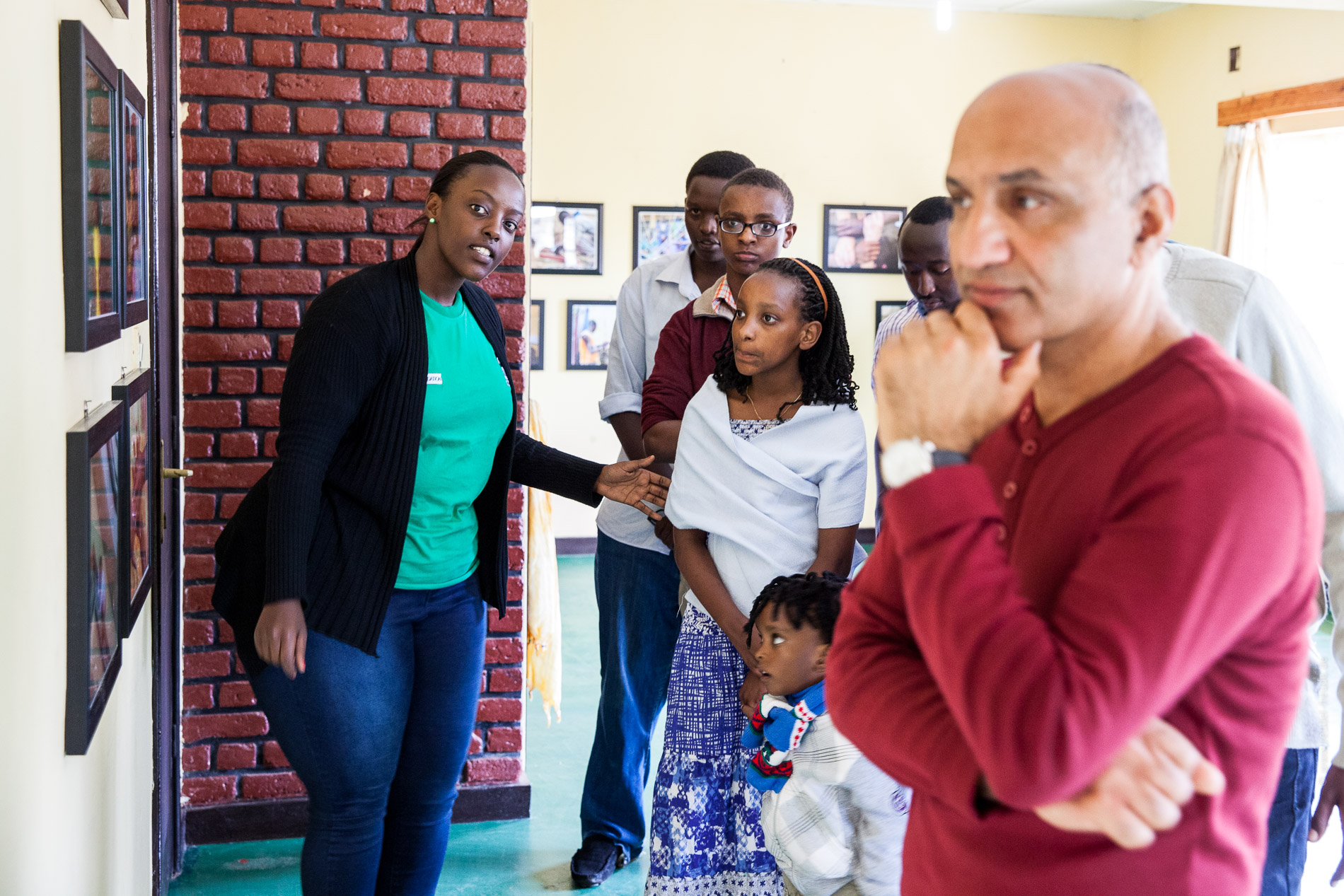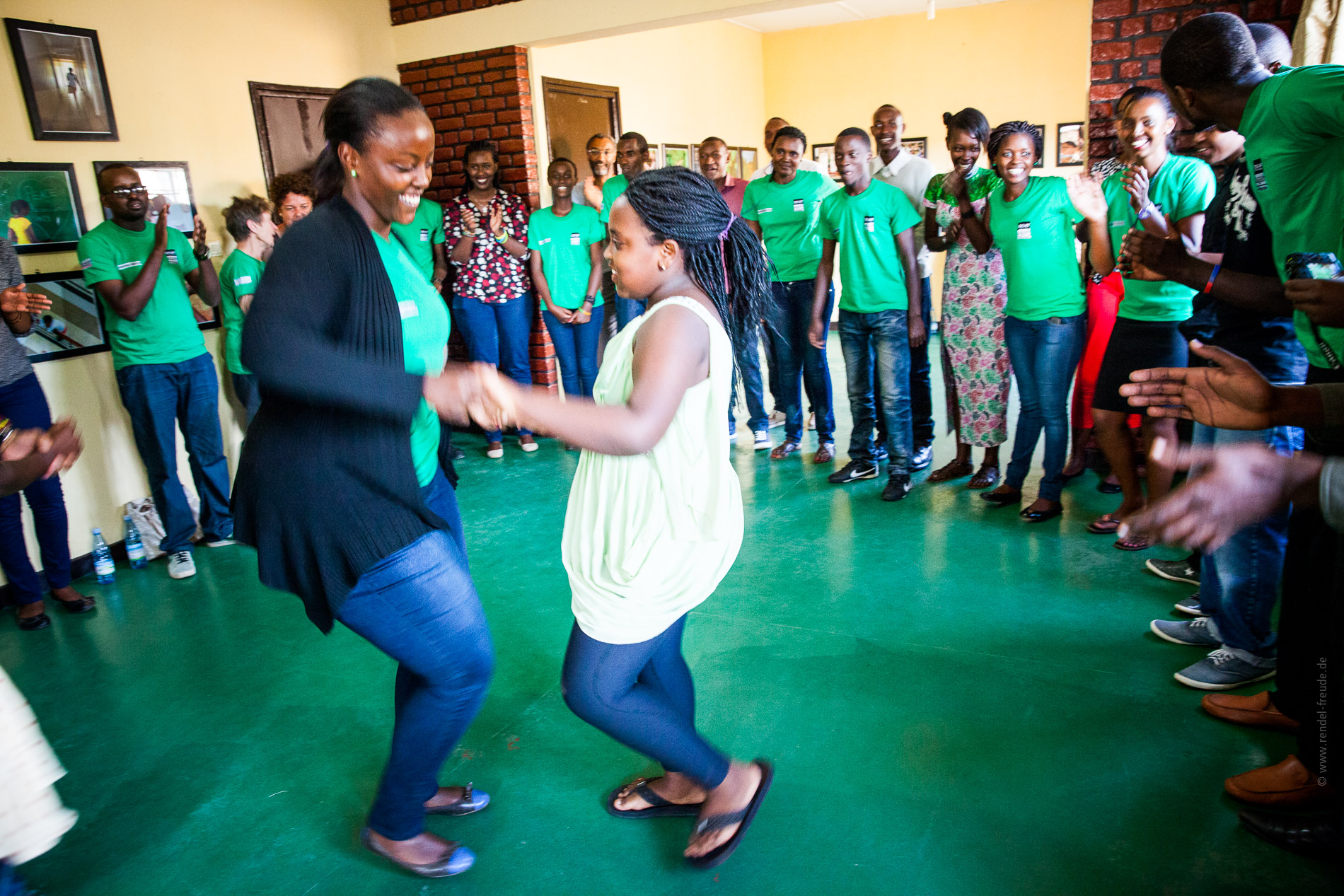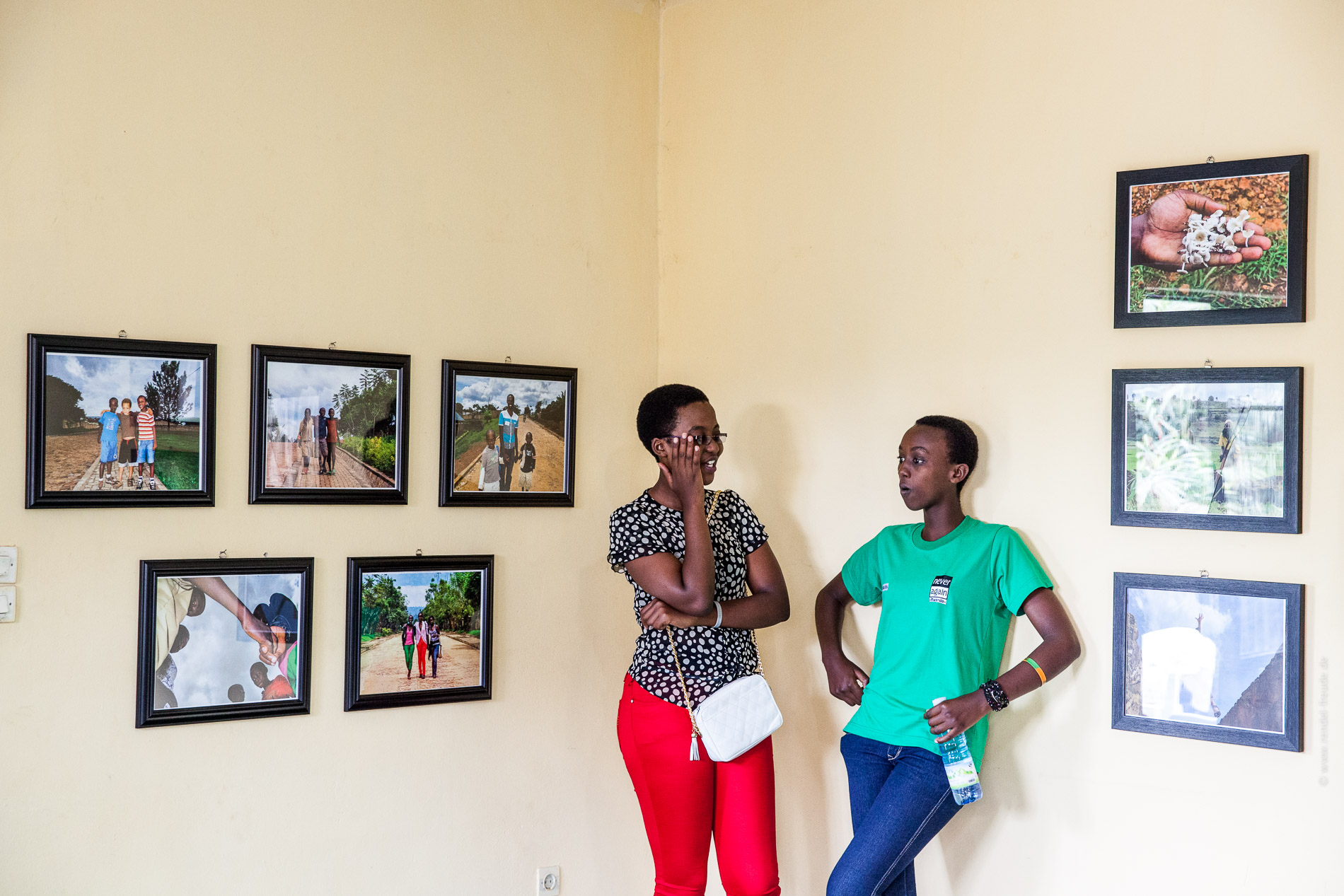November 2014 „When I can look into my own eyes, only then am I able to see others as they are“. That’s how 20-year-old Divine describes her photo series to visitors and what peace and reconciliation mean to her: peace with oneself allows approaching others, reaching out and building something together. An exhibition that includes 15 works of the participants is the visible and public result of the workshop in Rwanda.
We spent five days together during the workshop and, after a break of one week so the pictures could be developed, another day to hang the photographs up and finally exhibit them on Sunday at the NEVER AGAIN RWANDA (NAR) office in Huye, a university town in the south of Rwanda. NAR is a local youth organization founded in 1994 after the genocide committed to peace-building and conflict resolution. Last year, I was introduced to the organization in another context, and thus developed the idea for a photo workshop. The FREELENS foundation immediately approved my request for project funding and ensured a generous and uncomplicated processing.
The week: On Monday, ten young adults, aged between 16 and 29, all of whom are in High school or University and support the NEVER AGAIN RWANDA association, await me. Two of them are from Burundi, one from Congo and the others from Rwanda. Five among them are NAR staff members and want to use this course as opportunity to learn how to later offer workshops themselves.
Everyone is assorted well and several group rules are being established: don’t interrupt others while they’re speaking, only express positive criticism, leave your cell phone on silent mode and keep it in your bag. A time-keeper, a village chief (for the purpose of equality it has to be a woman) and a logistics expert are being selected. A profuse welcome and enthusiasm about the possibilities that might arise this week, and a round of introduction of the participants, the organization, the photographer (along with her plan for the week) and Kristin Kunze, my journey companion and a professional clown who is responsible for ice-breaker exercises, follows. We form a great team that is able to see and move in all directions.
After the completion of formalities, the cameras can finally be unpacked: the FREELENS foundation financed five simple cameras, a hard disk for the huge amount of photographs that are expected, as well as the logistics for the exhibition (frames and prints). NAR also lent some cameras from acquaintances, allowing the participants to form seven teams of two people who will be working together this week.
Some have never held a camera in their hands before, while others mention during the round of introduction that they know how to take photographs. In this vein they help each other unpacking and approaching the cameras for the first time. After taking the battery and memory card in, the cameras can finally be turned on!
First tries to take photographs: Target any chosen object and make sure that the camera focuses. What is an aperture, what is time, what is a sensor.
In the afternoon, heads begin to spin: we need to find a topic for the week and the exhibition. NEVER AGAIN RWANDA, and in particular the board of the association which is located far away in Kigali, has a great interest in pedagogical content that is in accordance with the association. Each team consists of two participants who brainstorm with terms such as peace work, reconciliation, art for peace, talking silence and the question how all of this can be translated into images.
Towards the end of the day, everyone is in need of loosening up and Kristin starts to form the participants into a group by movement and singing.
Tuesday is reserved for design basics and several exercises. What looks better: a portrait or landscape format? What is fore- and background? What makes sharpness/blurredness in a picture? The photo model has to show emotion. Take photographs of structures and lines, not of humans. For all exercises, it is requested to take as many photographs as you want, but to only take three pictures with you at the end (which isn’t that easy). With a beamer we look at the pictures several times and discuss them — and the faces of the learning photographers reveal a growing understanding. For me, it was important to teach the participants that taking photographs doesn’t only mean to press the shutter button, but that seeing, feeling and thinking are an important basis (if you use your head and heart, there are many ways to achieve your result)
In the afternoon, the participants discuss within their teams what it is they specifically want to take photographs of on Wednesday and Thursday.
During both days, the participants have time to move around Huye and take photographs freely. On Wednesday afternoon, I have individual discussions with everyone regarding their photography: What did you want to take photographs of, are you happy with the results, what could have changed the message of this or that picture? With the results and new ideas, the groups set off again on Thursday and take over 1500 pictures over the course of two days.
Thursday night I spent in front of the computer and draw up for each group two series of five pictures for the exhibition.
On Friday, the results are being presented, discussed and admired. Each group can decide which of the two series they like better and pick it for the exhibition. Some decide to mix photos of both.
In the afternoon, I introduce three participants to the programs Picasa and Gimp, both of which are free to download and are useful for the organization and editing of images (I download the programs the evening before in a restaurant that is known for its free wifi — however the electricity fails, the line is interrupted and I’m only able to download it via mobile connection at Irene’s)
After five days, the participants describe their experiences: the only thing they knew about taking photographs was to press buttons. Now, however, they developed an understanding of what it can mean to SEE, and that not only our eye but the photographer themselves is responsible for it.
All participants receive a certification for their participation and a green shirt with the logos of the FREELENS foundation, NEVER AGAIN RWANDA and the ZIVILER FRIEDENSDIENST (ZFD, a Civil Peace Service) from Germany that supports NEVER AGAIN RWANDA in an advisory capacity.
On the weekend, I edit the seven series and portraits of the participants so they are ready for printing. A CD is being transported via “bus-post” to Kigali and the following week a photo lab makes the prints (one half has to be reported for being faulty and printed again). The frames are being bought in Kigali as well and transported by Irene Erben of the ZFD to Huye. On Saturday, some participants meet to prepare the exhibition: Cleaning the frames (there are no window cleaners in Huye, so alternatives have to be found — and of course they are) and hanging the pictures up. The wall consists of concrete and the nails are as flexible as rubber. Nonetheless, a couple of hours later all pictures are on the wall, while the portraits are laid in a circle on the floor.
On Sunday, everyone is asked to arrive at nine in the exhibition room. Those that weren’t present on Saturday are seeing their photographs for the first time in a frame and pride and joy can be read from their faces.
The tasks of the day are being distributed: Receiving visitors, filling lists with their names and addresses, explaining during the exhibition what each photographer’s aim was (a tiring job for all, having to make the same rounds from morning till night).
In the afternoon, everyone is invited to participate in a discussion — participants and visitors sit in a circle and comment on the photographs, peace and development.
Movement is needed! We finish our exhibition with the circle dance and singing. “Bele Mama” and afterwards disco music are being played. The exhibition is presented a second time in mid-December — this time in a formal context in the city hall of Huye.
Wie es weitergeht? NAR verleiht die Kameras an die TeilnehmerInnen, wenn sie eigene Projekte starten wollen. Wir wollen dass es Folgeworkshops geben wird. Zur Zeit recherchieren wir sinnvolle Möglichkeiten, wie die StudentInnen online fotografisch weiterarbeiten und sich verbinden können.
What comes next? NAR distributes the cameras among the participants in case they want to start their own projects. We want following workshops to take place. At the moment we make enquiries for practical possibilities, so the students can continue working online on photography and connect.
Cologne, December 2014
